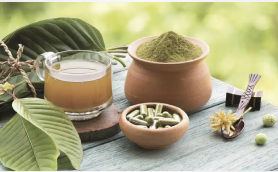The Mitragyna speciosa tree from Southeast Asia has gained attention regarding the possible health benefits and therapeutic uses of its product, called kratom. As its popularity grows, many wonder about its nutritional value, specifically: does kratom have calories?
This article explores kratom’s caloric presence and dives into its broader nutritional profile. We’ll examine factors affecting kratom’s caloric content, its potential health benefits, including antioxidant properties, and its role in energy boosting, immune support, and pain management.
Additionally, we assess if kratom can be a source of vitamins, carbohydrates, or fiber and detail its total caloric content.
Finally, we discuss optimal consumption methods, including dosage considerations and various intake techniques.
Does Kratom Have Calories?
Kratom, derived from the Mitragyna speciosa tree found in Southeast Asia, is frequently utilized for its psychoactive and medicinal properties. A common query regarding this botanical is its caloric content. White Sumatra kratom indeed contains a very small number of calories.
The calorie difference of kratom is fairly low and hence is negligible compared to our ordinary diet. To take a closer look, a single dose of kratom in powder form is roughly one teaspoon or zero five grams and supplies anywhere from 2 to 5 calories coming mainly from carbohydrates in the form of dietary fiber. What is worth mentioning is its calorie content, so kratom practically does not make you gain weight and gives a food compromise.
For those managing their caloric intake or on a calorie-controlled diet, kratom offers a way to enjoy its potential health benefits without significant concern for calorie disruption, thereby supporting weight management efforts while providing therapeutic effects.
What Factors Affect the Caloric Content of Kratom?
Kratom, known scientifically as Mitragyna speciosa, is primarily sought after for its psychoactive properties, which can vary from stimulating to sedative depending on the dose and strain. While the caloric content of kratom is not a widely discussed topic—given its use in powdered or leaf form for tea rather than as a conventional food item—there are a few considerations that could theoretically influence its caloric value.
Firstly, the inherent nature of kratom leaves themselves might contain a minimal amount of calories, as with most plant-based materials.
However, this would be exceedingly low and likely negligible in a standard diet. The process of drying and powdering the leaves, which is how kratom is commonly consumed, does not significantly alter its caloric content.
Secondly, the method of consumption could play a role. When kratom is used to make tea, it’s often consumed without the actual leaf material, meaning any caloric intake would be minimal. However, if the powdered leaves are ingested directly—such as through the “toss and wash” method or mixed into food—the body may absorb more of the plant’s minimal caloric content.
Besides that, combos or extras make the calorie intake greater than the usage of kratom. As an example, let us compare adding kratom to a sugary drink or a kind of smoothie, and the number of calories provided by additives in those recipes surpasses anything offered by kratom powder.
Kratom Nutrition Benefits
It is known that kratom is often used for psychological effects along with therapeutic effects. This medicinal product can be beneficial for endurance and functionality. There are two major compounds that kratom contains, the mitragynine and 7-hydroxymitragynine alkaloids, which are believed to be the principal actors in the vigor that kratom provides.
Antioxidant Properties:
Kratom contains significant antioxidants that may reduce oxidative damage and lower the risk of various diseases. The antioxidants found in kratom plants can bind up these free radicals, and thus, they may protect cells and tissues against cellular damage.
Boosting Energy Levels:
A large number of users state that having a stimulant effect at lower doses, kratom is a beneficial energizer, too. Therefore, kratom is in high favor among those who require a lift in energy levels without coffee side effects that include jitters.
Supporting Immune Function:
The various alkaloids in kratom have restrained immune-power enhancements. The properties associated with water may be capable of strengthening the body’s natural immune system. This benefit, however, could be due to several factors, so scientific research in this field still needs to clarify the specific effects of the mineral.
Managing Pain and Inflammation:
Kratom is the most popular plant-based pain relief medication because of its remarkable pain-killing properties. It impacts pain receptors in the body and can potentially reduce inflammation considerably, so it becomes a logical alternative for chronic patients.
Understanding these nutritional benefits helps clarify why kratom might be more than just a recreational herb, highlighting its potential role in supporting physical health and well-being.
Can Kratom Be a Source of Vitamins?
The main thing that kratom is known for is its psychotropic and therapeutic properties. But, naturality requires wondering whether it also contains nutritive substances like vitamins.
Kratom possesses all sorts of compounds, and some, like alkaloids, flavonoids, and other phytochemicals, are responsible for its medicinal properties. However, the traditional vitamins in kratom are less effective or not well documented compared to other botanical herbal practices.
Kratom leaves do contain some vitamins and minerals. They also provide a pinch of Vitamin C and a variety of B-vitamins crucial for energy metabolism and general well-being.
Although these amounts are not sufficient to classify kratom as a high-vitamin supplement, they do contribute to its overall nutritional profile.
It should be noted that the main added value of kratom is not in the vitamin content of a pill. Hopefully, the role of its special alkaloids, mitragynine, on opioid receptors in the brain is still one of the many different effects.
These chemicals are the ones that are responsible for the opioid, the euphoric, and the sedating properties that are usually experienced when taking this herb.
People who are trying to increase their vitamin intake should not stay on kratom only because it would not be right. Nevertheless, if used responsibly, kratom can be a part of a comprehensive health and well-being program that includes a balanced diet rich in all the vital nutrients necessary for good health.
Does Kratom Have Carbs?
As kratom, derived from the Mitragyna speciosa tree, grows in popularity, questions about its nutritional content, like its carbohydrate levels, emerge.
Kratom has traces of carbohydrates, which are mostly recognized as dietary fiber, making it a fun low-carb plant material. This low carbohydrate content makes it a proper meal selection for those consciously minding their carbohydrate intake.
The special carbohydrate levels in kratom depend on the leaves’ age, the diversity of strains, and the technology used to process it. The portion is almost negligible in the sense that it virtually does not affect a person’s normal daily carbohydrate intake.
For instance, a standard dose of kratom powder (around one teaspoon or roughly 2.5 grams) holds less than a gram of dietary fiber and virtually no other simple or complex carbohydrates.
This negligible carb content is particularly beneficial for those on ketogenic diets or anyone attempting to reduce sugar and starch intake.
Even though kratom gives quite a bit of dietary fiber, which would be of significant help for a digestion system, it cannot be suggested as a significant source of carbohydrates or fiber.
Generally, kratom has a low carbohydrate effect, making it an attractive option for people on low-carb diets. Still, it should be integrated thoughtfully among dieting along with the entire health routine.
Does Kratom Have Fiber?
Kratom is a Mitragyna tree species in Southeast Asia. It contains a small amount of dietary fiber, glycosides, and alkaloids.
Kratom fiber mainly contains insoluble forms, which have been proven essential in proper digestion. Insoluble fiber is one of the most valuable ingredients for helping digestion by contributing to better stool movements and adding bulk.
The fiber of this form does not break off in water like that; it simply passes through the digestive system unaltered and is, therefore, one of the foods involved in intestinal health.
Kratom can, indeed, be a great choice of drink for weight management, as it features insoluble fiber. Dietary fiber is well-known for its ability to cause an eager feeling of fullness, which helps avoid overeating.
By contributing to a sense of fullness after meals, kratom’s fiber content can potentially help in reducing overall calorie intake, thus supporting weight management efforts.
In a typical dose, such as one teaspoon or approximately 2.5 grams of kratom powder, the fiber content is generally less than one gram. This amount is considerably low compared to the daily recommended intake of fiber—25 grams for women and 38 grams for men, as the American Heart Association recommends.
Therefore, while kratom does provide some dietary fiber, it falls short of being a significant source.
Given this information, it’s clear that individuals using kratom for its various effects should not rely on it as their sole source of fiber.
For example, to ensure saturation of needed dietary fiber and good digestive health, a kratom user must include other fiber-enriched edibles (for instance, fruits, vegetables, legumes, and whole grains) in his or her diet. This balanced plan will ensure that the dietary needs and pleasure of kratom are balanced.
How Many Calories Are in Kratom?
For the people who now want to take kratom in their diet, getting an informed view of its calorie value is extremely important. Kratom – the major constituent of the leaves of the Mitragyna speciosa tree – is mainly used as a therapeutic agent because it gives you relief from pain, makes you feel loving, and promotes energy.
If we consider kratom’s nutritional score regarding the calorie count, it is one of the most deficient options that can satisfy the needs of calorie-restricted individuals.
Kratom leaves themselves contain minimal calories. Since the calories contained in kratom are so insignificant, it is normally neglected as far as calorie value is concerned in a typical meal or even in a meal for a day.
A case in point is kratom powder, the frequently used dosage of which is around one teaspoon, which equals 2.5 grams. This particular amount provides only 2 to 5 calories. These calories come as very small amounts of carbohydrates – dietary fiber in the leaves as many people consume.
This low-calorie count is particularly beneficial for those looking to manage their weight. Since kratom does not significantly affect daily caloric intake, it can be used without disrupting a calorie-restricted diet.
Moreover, the dietary fiber in kratom can promote satiety, further aiding in weight management by helping individuals feel fuller for longer periods, which potentially decreases overall calorie consumption.
However, kratom offers a way to enjoy its various health and therapeutic benefits without the concern of adding substantial calories to your diet. This makes it a suitable addition for those managing their weight or anyone interested in maintaining a low-calorie diet.
What Is the Best Way to Take Kratom?
The type of kratom intake is determined by the user’s personal needs, the effects they hope to attain, and convenience. Kratom, a botanic product obtained from the Mitragyna speciosa tree, may be taken in various ways. Each might have its own merits or demerits regarding the dosage and other preparation methods.
Kratom Dosage Considerations
The best dosage of kratom is always based on personal tolerance, strain type, and the person’s goal —whether it´s pain relief, energy boost, or calming effect. Newbies can start with a small dose, 1-2 grams, and then increase it until they achieve their personal best. This is significant in order to monitor the changes in the body’s condition and make the necessary changes.
Methods of Kratom Consumption
-
Toss and Wash Technique:
One way to do it is to mix kratom powder in a glass of water or other drink and drink it fast. This is why people prefer fast absorption but to undermine the bitter taste.
-
Kratom Tea Preparation:
Utilizing the leaves or the leaves powder for making a drink not only determines the smoothness and duration of kratom’s effect but can also increase the herb’s natural qualities. It also allows users to sweeten the tea to improve flavor.
-
Kratom Capsules or Tablets:
Capsules and tablets are the favorites of those who want to avoid the bittering taste of kratom. It is easy, convenient, and tastes good. This technique gives an accurate dosage; however, due to the capsule dissolving, there might be a delay in when the effect can take place.
Each method has its benefits and drawbacks, so the best way to take kratom is the one that aligns with your lifestyle and how your body responds to the herb. For accurate dosing and to minimize potential side effects, it’s advisable to measure the kratom carefully, start with a lower dose, and adjust as needed based on your experiences.
Conclusion
This article was centered on the nutritional profile of kratom, an extract from Southeast Asian Mitragyna speciosa which primarily focuses on the calorie count and wider nutritional benefits of the said product. We found that kratom contains a negligible amount of calories, typically 2 to 5 per serving, mainly from minimal carbohydrates in the form of dietary fiber.
We also highlighted kratom’s health benefits, including its antioxidant properties and its ability to boost energy, support immune function, and manage pain and inflammation. Although low in vitamins, kratom does provide some essential minerals and vitamins that contribute to its nutritional value.
We reviewed different ways of consumption, specifically the “toss and wash” method, tea preparation, and capsules. Each offers advantages depending on personal preferences and lifestyle needs.
To sum up, kratom provides therapeutic benefits without a significant caloric load that should be highly considered by calorie watchers and those interested in natural remedies.
FAQs
Can Kratom Help with Weight Management?
Kratom can indirectly contribute to weight control as it tends to suppress appetite, especially at high doses. Moreover, lower doses have stimulating effects on energy, which may improve the level of physical activity and in turn, help with weight loss. Nevertheless, the use of kratom should be responsible and part of a larger health and diet regime because it is not a miracle cure for obesity.
Does Kratom Have Caffeine?
No, kratom does not contain caffeine. The energy-boosting effects of kratom are due to its active compounds, primarily mitragynine, which can stimulate alertness and energy in a manner that some users find similar to the effects of caffeine but without the caffeine itself.
How much kratom is in a capsule?
The amount of kratom in a capsule can vary depending on the size and density of the capsule. Typically, a standard-sized 00 capsule contains about 0.5 grams of kratom powder, but this can vary slightly.
Can kratom be used to increase energy levels?
Yes, kratom can be used to increase energy levels. Many users report that lower doses of kratom are stimulating, helping to enhance focus and stamina, which contrasts with higher doses that tend to be more sedative.
Can Kratom be considered a useful dietary supplement?
Although not approved as a supplement by health authorities like the FDA, kratom is used by many people in their diet for a range of its medicinal properties, such as pain relief and mood-lifting, and as a tool in fighting withdrawal from opioids.
Does kratom expire?
Kratom does have a shelf life and is known to expire, which is usually around one to three months if stored properly. For a long kratom life, it must be kept in a cold and dry place with no sunlight. Under the proper storage conditions, kratom may have a shelf life of six months to one year. Check for signs of mildew and strange smells as indications that kratom may have gone bad.





















